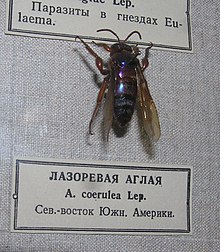Aglae
| Aglae | |
|---|---|

| |
| Scientific classification | |
| Domain: | Eukaryota |
| Kingdom: | Animalia |
| Phylum: | Arthropoda |
| Class: | Insecta |
| Order: | Hymenoptera |
| Family: | Apidae |
| Genus: | Aglae Lepeletier & Serville, 1825 |
| Species: | A. caerulea
|
| Binomial name | |
| Aglae caerulea Lepeletier & Serville, 1825
| |
Aglae is a genus of euglossine bees, with the only described species Aglae caerulea. Like all orchid bees, it is restricted to the Neotropics.
They are metallic blue.
This species, like the genus Exaerete, is a nest parasite on free-living Euglossini. A. caerulea lays its eggs in the nests of Eulaema nigrita, and possibly other Eulaema species.
Among other substances, males of this species are attracted by methyl cinnamate baits.
Name
The Ancient Greek Αγλαιη means "beauty".
Distribution
A. caerulea was thought to occur only in the Amazon basin, in the rainforests of northern Bolivia, western Colombia, Ecuador, French Guiana, Guyana, Peru, Venezuela, Suriname and Panama. However, the record from Panama is doubtful. Recent studies have extended the range by about 2,400 km southwards, when specimens were found in the National Park Chapada dos Guimarães, Mato Grosso, Brazil.[1]
Footnotes
- ^ dos Anjos-Silva et al. 2006
References
- Williams, Norris H. & Whitten, W. Mark (1983): Orchid floral fragrances and male euglossine bees: methods and advances in the last sesquidecade. Biol. Bull. 164: 355-395.
- dos Anjos-Silva, Evandson J.; Camillo, Evandro & Garófalo, Carlos A. (2006): Occurrence of Aglae caerulea Lepeletier & Serville (Hymenoptera: Apidae: Euglossini) in the Parque Nacional da Chapada dos Guimarães, Mato Grosso State, Brazil. Neotrop. Entomol. 35(6) doi:10.1590/S1519-566X2006000600024
- "Aglae". Integrated Taxonomic Information System. Retrieved 12 June 2008.
Further reading
- Cameron, Sydney A. (2004): Phylogeny and Biology of Neotropical Orchid Bees (Euglossini). Annual Review of Entomology 49: 377-404. doi:10.1146/annurev.ento.49.072103.115855
External links
- David Roubik (Smithsonian Tropical Research Institute): Diagnostic photographs of Aglae caerulea
